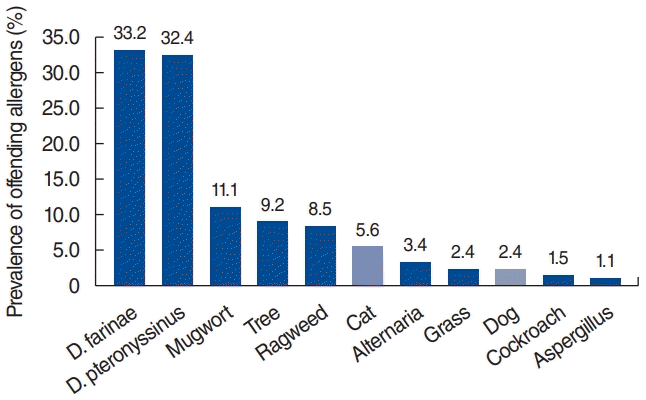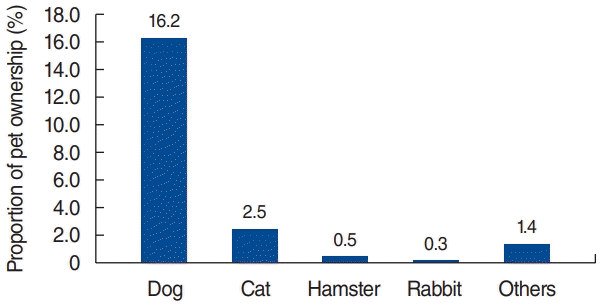1. Bousquet J, Khaltaev N, Cruz AA, Denburg J, Fokkens WJ, Togias A, et al. Allergic Rhinitis and its Impact on Asthma (ARIA) 2008 update (in collaboration with the World Health Organization, GA(2)LEN and AllerGen). Allergy. 2008; Apr. 63 Suppl 86:8–160.
2. Vinke JG, KleinJan A, Severijnen LW, Hoeve LJ, Fokkens WJ. Differences in nasal cellular infiltrates between allergic children and agematched controls. Eur Respir J. 1999; Apr. 13(4):797–803.

3. Perzanowski MS, Ronmark E, Platts-Mills TA, Lundback B. Effect of cat and dog ownership on sensitization and development of asthma among preteenage children. Am J Respir Crit Care Med. 2002; Sep. 166(5):696–702.

4. Craig TJ, King TS, Lemanske RF Jr, Wechsler ME, Icitovic N, Zimmerman RR Jr, et al. Aeroallergen sensitization correlates with PC(20) and exhaled nitric oxide in subjects with mild-to-moderate asthma. J Allergy Clin Immunol. 2008; Mar. 121(3):671–7.

5. Kim DH, Park YS, Jang HJ, Kim JH, Lim DH. Prevalence and allergen of allergic rhinitis in Korean children. Am J Rhinol Allergy. 2016; May. 30(3):72–8.

6. Salo PM, Zeldin DC. Does exposure to cats and dogs decrease the risk of allergic sensitization and disease. J Allergy Clin Immunol. 2009; Oct. 124(4):751–2.

7. Kerkhof M, Wijga AH, Brunekreef B, Smit HA, de Jongste JC, Aalberse RC, et al. Effects of pets on asthma development up to 8 years of age: the PIAMA study. Allergy. 2009; Aug. 64(8):1202–8.
8. Almqvist C, Egmar AC, van Hage-Hamsten M, Berglind N, Pershagen G, Nordvall SL, et al. Heredity, pet ownership, and confounding control in a population-based birth cohort. J Allergy Clin Immunol. 2003; Apr. 111(4):800–6.

9. Bornehag CG, Sundell J, Hagerhed L, Janson S; DBH Study Group. Pet-keeping in early childhood and airway, nose and skin symptoms later in life. Allergy. 2003; Sep. 58(9):939–44.

10. Arshad SH, Tariq SM, Matthews S, Hakim E. Sensitization to common allergens and its association with allergic disorders at age 4 years: a whole population birth cohort study. Pediatrics. 2001; Aug. 108(2):E33.

11. Lindfors A, van Hage-Hamsten M, Rietz H, Wickman M, Nordvall SL. Influence of interaction of environmental risk factors and sensitization in young asthmatic children. J Allergy Clin Immunol. 1999; Oct. 104(4 Pt 1):755–62.

12. Munir AK, Kjellman NI, Bjorksten B. Exposure to indoor allergens in early infancy and sensitization. J Allergy Clin Immunol. 1997; Aug. 100(2):177–81.

13. Ownby DR, Johnson CC. Does exposure to dogs and cats in the first year of life influence the development of allergic sensitization. Curr Opin Allergy Clin Immunol. 2003; Dec. 3(6):517–22.

14. Hesselmar B, Aberg N, Aberg B, Eriksson B, Bjorksten B. Does early exposure to cat or dog protect against later allergy development. Clin Exp Allergy. 1999; May. 29(5):611–7.

15. Ritz BR, Hoelscher B, Frye C, Meyer I, Heinrich J. Allergic sensitization owing to ‘second-hand’ cat exposure in schools. Allergy. 2002; Apr. 57(4):357–61.

16. Park YB, Mo EK, Lee JY, Kim JH, Kim CH, Hyun IG, et al. Association between pet ownership and the sensitization to pet allergens in adults with various allergic diseases. Allergy Asthma Immunol Res. 2013; Sep. 5(5):295–300.

17. Roost HP, Kunzli N, Schindler C, Jarvis D, Chinn S, Perruchoud AP, et al. Role of current and childhood exposure to cat and atopic sensitization. European Community Respiratory Health Survey. J Allergy Clin Immunol. 1999; Nov. 104(5):941–7.
18. Arbes SJ Jr, Cohn RD, Yin M, Muilenberg ML, Friedman W, Zeldin DC. Dog allergen (Can f 1) and cat allergen (Fel d 1) in US homes: results from the National Survey of Lead and Allergens in Housing. J Allergy Clin Immunol. 2004; Jul. 114(1):111–7.

19. Heinrich J, Bedada GB, Zock JP, Chinn S, Norback D, Olivieri M, et al. Cat allergen level: its determinants and relationship to specific IgE to cat across European centers. J Allergy Clin Immunol. 2006; Sep. 118(3):674–81.

20. Zheng T, Niu S, Lu B, Fan X, Sun F, Wang J, et al. Childhood asthma in Beijing, China: a population-based case-control study. Am J Epidemiol. 2002; Nov. 156(10):977–83.

21. Custovic A, Hallam CL, Simpson BM, Craven M, Simpson A, Woodcock A. Decreased prevalence of sensitization to cats with high exposure to cat allergen. J Allergy Clin Immunol. 2001; Oct. 108(4):537–9.

22. Custovic A, Simpson BM, Simpson A, Hallam CL, Marolia H, Walsh D, et al. Current mite, cat, and dog allergen exposure, pet ownership, and sensitization to inhalant allergens in adults. J Allergy Clin Immunol. 2003; Feb. 111(2):402–7.

23. Oryszczyn MP, Annesi-Maesano I, Charpin D, Kauffmann F. Allergy markers in adults in relation to the timing of pet exposure: the EGEA study. Allergy. 2003; Nov. 58(11):1136–43.

24. Ownby DR, Johnson CC, Peterson EL. Exposure to dogs and cats in the first year of life and risk of allergic sensitization at 6 to 7 years of age. JAMA. 2002; Aug. 288(8):963–72.

25. Linneberg A, Nielsen NH, Madsen F, Frolund L, Dirksen A, Jorgensen T. Pets in the home and the development of pet allergy in adulthood. The Copenhagen Allergy Study. Allergy. 2003; Jan. 58(1):21–6.

26. Jaakkola JJ, Jaakkola N, Piipari R, Jaakkola MS. Pets, parental atopy, and asthma in adults. J Allergy Clin Immunol. 2002; May. 109(5):784–8.

27. Platts-Mills TA, Woodfolk JA, Erwin EA, Aalberse R. Mechanisms of tolerance to inhalant allergens: the relevance of a modified Th2 response to allergens from domestic animals. Springer Semin Immunopathol. 2004; Feb. 25(3-4):271–9.

28. Apelberg BJ, Aoki Y, Jaakkola JJ. Systematic review: exposure to pets and risk of asthma and asthma-like symptoms. J Allergy Clin Immunol. 2001; Mar. 107(3):455–60.

29. Langan SM, Flohr C, Williams HC. The role of furry pets in eczema: a systematic review. Arch Dermatol. 2007; Dec. 143(12):1570–7.
30. Takkouche B, Gonzalez-Barcala FJ, Etminan M, Fitzgerald M. Exposure to furry pets and the risk of asthma and allergic rhinitis: a metaanalysis. Allergy. 2008; Jul. 63(7):857–64.

31. Pelucchi C, Galeone C, Bach JF, La Vecchia C, Chatenoud L. Pet exposure and risk of atopic dermatitis at the pediatric age: a meta-analysis of birth cohort studies. J Allergy Clin Immunol. 2013; Sep. 132(3):616–22.
32. Kaiser L, Gronlund H, Sandalova T, Ljunggren HG, van Hage-Hamsten M, Achour A, et al. The crystal structure of the major cat allergen Fel d 1, a member of the secretoglobin family. J Biol Chem. 2003; Sep. 278(39):37730–5.

33. Virtanen T. Lipocalin allergens. Allergy. 2001; 56 Suppl 67:48–51.

34. Mims JW. Asthma: definitions and pathophysiology. Int Forum Allergy Rhinol. 2015; Sep. 5 Suppl 1:S2–6.

35. Eichenfield LF, Tom WL, Chamlin SL, Feldman SR, Hanifin JM, Simpson EL, et al. Guidelines of care for the management of atopic dermatitis: section 1: diagnosis and assessment of atopic dermatitis. J Am Acad Dermatol. 2014; Feb. 70(2):338–51.




 PDF
PDF Citation
Citation Print
Print





 XML Download
XML Download